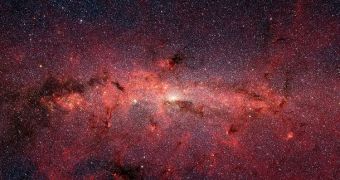Recent astronomical observations seem to point at the fact that the Milky Way, our own galaxy, is currently colliding with a dark, high-velocity cloud of hydrogen gas, known as Smith's Cloud. The formation may be a galaxy in itself, according to the most recent hypothesis, and not a common one. In fact, astronomers believe, the fact that the structure has the mass of about one million Suns seems to point at a single conclusion, namely that it is a dark matter galaxy, a long-proposed clump of the form of matter that can explain how galaxies come together in the skies.
The trajectory that the High-Velocity Cloud (HVC) has would seem to indicate that this is not the first time it passed through the Milky Way. Following this line of reasoning, astrophysicists determined that the structure must have passed through our home once more in the past, about 70 million years ago. If the cloud survived the first passing, then it means that it must have a lot more mass than previously estimated. Mass dictates gravity, and gravity is the only force that is strong enough to ensure that such a cloud is not ripped apart by the massive force the core of the Milky way exerts on it.
In a new study, performed by a team of scientists at the University of Sydney, in Australia, it has been revealed that the cloud must have at least 100 times more mass than previously estimated. The new mathematical calculations were made by experts Matthew Nichols and Joss Bland-Hawthorn, the leaders of the investigation efforts. It is widely believed that Smith's Cloud will impact our galaxy at a 45-degree angle, and that the phenomenon will trigger the formation of a neutral hydrogen super-shell, or even an increased level of stellar formation, in the most active areas around the Milky Way's core.
The new study may also help clear out one of the most puzzling mysteries about our galaxy. Around other similar structures, scientific observations have identified up to 1,000 dwarf galaxies, accompanying the behemoths of the skies, such as the Milky Way. But, around our own, there are only a few such structures, which has always made astronomers wonder where all the others went. Smith's Cloud may be an indicator that the dwarf structures are dark galaxies, which are all invisible if astronomers don't know what to look for. In this respect, these galaxies may be circling us even now.
Details of the recent study can be found here.

 14 DAY TRIAL //
14 DAY TRIAL //